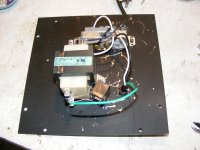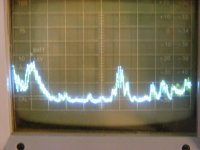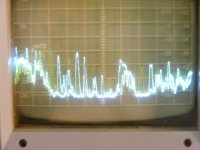Hi Vladimir,
Yes, even noise loading is not really a diagnostic. If (within the limits of the test equipment) the DUT shows a great difference between what we predict from the HD/IMD testing, we know we have a hidden problem and we know how big it is, but we cannot diagnose, other than by trial/error.
Well, I am generally NOT happy with what we got, however by combining it with experience and listening tests I find results can be gotten... A better theory would be nice to have, but I'm happy with just knowing what works in practice, even if that Ulianov Bloke said that practice without theory is blind, hey, that should suit the DBT crowd to a T...
Ciao T
To me, this is quite clear at qualitative level, and I realize how much it is more difficult to provide some quantitative measurements and proofs.
Yes, even noise loading is not really a diagnostic. If (within the limits of the test equipment) the DUT shows a great difference between what we predict from the HD/IMD testing, we know we have a hidden problem and we know how big it is, but we cannot diagnose, other than by trial/error.
But, unfortunately, most probably, nothing will change in education and common practice, until some extraordinary person will spend all his efforts to resolving the problem down to everybody's understanding. Until this has not happened, thousands and thousands of professionals and DIYers will be happy with simulations and spectra measurements.
Well, I am generally NOT happy with what we got, however by combining it with experience and listening tests I find results can be gotten... A better theory would be nice to have, but I'm happy with just knowing what works in practice, even if that Ulianov Bloke said that practice without theory is blind, hey, that should suit the DBT crowd to a T...
Ciao T
Hi,
Well, who knows...
Here is something to boil your noodle though. It comes from Jan Didden's often excellent website:
So, how do the neurons know to start acting before you decided?
Does free will exist? If so it would appear time ain't exactly what it cracked up to be...
Ciao T
What I want to know is, how can anything be predictable to an amplifier?
Well, who knows...
Here is something to boil your noodle though. It comes from Jan Didden's often excellent website:
Jan Didden said:
So, how do the neurons know to start acting before you decided?
Does free will exist? If so it would appear time ain't exactly what it cracked up to be...
Ciao T
or more people will realize that listening evaluation is more revealing than conventional measurements.
This is doubtful at the nearest future, since dominating pop-culture does not produce demand for high quality audio, only for loud enough audio. Those who serve for the pop-culture can be happy enough with existing hi-fi quality criteria.
Or should we believe, that history will bring us back to 1970-ies, when definite achievents in analog audio took place ? I doubt, good analog will exist further either as an exclusive, or at DIY level, with a perspective that less and less good parts (transistors) will be available. DIYers, look at future, make your stores.
Last edited:
What I want to know is, how can anything be predictable to an amplifier?
se
S.E.
Let's look at a simple resistor. It produces some very low levels of distortion. For most resistors there is a third harmonic distortion that is related to the thermal variation of resistance. This decreases with increasing frequency of a sine wave test signal. Now if there is a sine wave of several seconds duration the resistor temperature will rise reasonably uniformly.
However if there is a spike type of waveform, for example the attack of a musical note, the heating is much more rapid and is proportional to Voltage squared. This would then be followed by a diminishing heating effect as the envelope of the signal decreased. This would produce a different distortion profile than the steady state sine wave.
Then there is what is often classed as a voltage coefficient distortion that may be related to thermoelectric differences. If the resistor has different contact quality on one end versus the other the localized heating due to an impulse and a steady state waveform will be different.
There are similar thermal effects in other components notably semiconductors.
Now as time or at least this thread is circular, memory can be the same as prediction!
ES
Last edited:
that our conscious is a delayed construct, a heavily edited, "executive summary" of our neural activity, sensory inputs is no great insight
Blind, controlled listening evaluation really is the only acceptable evidence that the perceived differences are due to the sound waves entering your ears - perceptual psychology is very clear on the multiple "internal" influences that easily override the actual sensory stimuli
and a long history of psychoacoustic investigation also shows level, frequency response controls are absolutely required
when differences are shown in such controlled listening tests - then we have something to work with
Blind, controlled listening evaluation really is the only acceptable evidence that the perceived differences are due to the sound waves entering your ears - perceptual psychology is very clear on the multiple "internal" influences that easily override the actual sensory stimuli
and a long history of psychoacoustic investigation also shows level, frequency response controls are absolutely required
when differences are shown in such controlled listening tests - then we have something to work with
Last edited:
S.E.
Let's look at a simple resistor. It produces some very low levels of distortion. For most resistors there is a third harmonic distortion that is related to the thermal variation of resistance. This decreases with increasing frequency of a sine wave test signal. Now if there is a sine wave of several seconds duration the resistor temperature will rise reasonably uniformly.
However if there is a spike type of waveform, for example the attack of a musical note, the heating is much more rapid and is proportional to Voltage squared. This would then be followed by a diminishing heating effect as the envelope of the signal decreased. This would produce a different distortion profile than the steady state sine wave.
Then there is what is often classed as a voltage coefficient distortion that may be related to thermoelectric differences. If the resistor has different contact quality on one end versus the other the localized heating due to an impulse and a steady state waveform will be different.
There are similar thermal effects in other components notably semiconductors.
Now as time or at least this thread is circular, memory can be the same as prediction!
ES
If I would be allowed to estimate this post, I would say it is so elegantly written, as if an author would be Audio Mark Twain.
Hi,
FWIW, the AP2 also looks much worse running something akin to a noise-load test than when running single tones. Now I do not loose sleep about this, as the AP2 is not designed to operate in this test.
Ciao T
Neither was the spectrum analyser. The reasons are pretty obvious and related to the spectral energy distribution of the signal. Nothing is wrong with
either instrument.
S.E.
Let's look at a simple resistor. It produces some very low levels of distortion. For most resistors there is a third harmonic distortion that is related to the thermal variation of resistance. This decreases with increasing frequency of a sine wave test signal. Now if there is a sine wave of several seconds duration the resistor temperature will rise reasonably uniformly.
However if there is a spike type of waveform, for example the attack of a musical note, the heating is much more rapid and is proportional to Voltage squared. This would then be followed by a diminishing heating effect as the envelope of the signal decreased. This would produce a different distortion profile than the steady state sine wave.
Then there is what is often classed as a voltage coefficient distortion that may be related to thermoelectric differences. If the resistor has different contact quality on one end versus the other the localized heating due to an impulse and a steady state waveform will be different.
There are similar thermal effects in other components notably semiconductors.
Now as time or at least this thread is circular, memory can be the same as prediction!
ES
Ed, it is trivial to size resistors in low level circuits to make these issues unmeasurable and irrelevant, but of course we've been over this adnauseum.
Ed, it is trivial to size resistors in low level circuits to make these issues unmeasurable and irrelevant, but of course we've been over this adnauseum.
You would think so, but all too often I see it done incorrectly. I just had an amplifier manufacturer here demonstrating his wares. Yes a 1/4 watt metal film 22,000 ohm resistor was used as the feedback resistor in an amplifier with an open circuit voltage of greater than 100 volts. Now in normal operation the resistor will only see 10 to 30 volts, but how it ever passed bench testing is an interesting question.
But the issue was "Is it possible for a mechanism to exist that behaves differently for steady state sine waves versus impulse response." The answer is that I can point to one easily explained mechanism, there most likely are more.
This is doubtful at the nearest future, since dominating pop-culture does not produce demand for high quality audio, only for loud enough audio. Those who serve for the pop-culture can be happy enough with existing hi-fi quality criteria.
For all I can tell, you are correct.
However I wasn't referring to pop-culture consumers and manufacturers…
Ed,
And most likely thy all are operational at the same time, some effects will interact with others and the whole shooting match will show a lot of interesting and possibly amusical behaviour when few with real music, not 1KHz sinewaves...
Ciao T
But the issue was "Is it possible for a mechanism to exist that behaves differently for steady state sine waves versus impulse response." The answer is that I can point to one easily explained mechanism, there most likely are more.
And most likely thy all are operational at the same time, some effects will interact with others and the whole shooting match will show a lot of interesting and possibly amusical behaviour when few with real music, not 1KHz sinewaves...
Ciao T
You would think so, but all too often I see it done incorrectly. I just had an amplifier manufacturer here demonstrating his wares. Yes a 1/4 watt metal film 22,000 ohm resistor was used as the feedback resistor in an amplifier with an open circuit voltage of greater than 100 volts. Now in normal operation the resistor will only see 10 to 30 volts, but how it ever passed bench testing is an interesting question.
This, of course, will show up in those supposedly-irrelevant distortion measurements.
This, of course, will show up in those supposedly-irrelevant distortion measurements.
And it does! But as a "Pro" amplifier they thought .1% THD at 1/2 power was typical of that class.
Hi,
Well, who knows...
Here is something to boil your noodle though. It comes from Jan Didden's often excellent website:
So, how do the neurons know to start acting before you decided?
Does free will exist? If so it would appear time ain't exactly what it cracked up to be...
Ciao T
How do they determine when you decided? It takes time to communicate a decision? How do they know they are not just measuring the decision process? A lot things go on in the brain to make a decision.
This is a picture of my noise test set and the proof of concept.
The source is nothing more than an extension cord with a power transformer wired right across the outlet. The transformer steps 120 volts down to about 15 volts where it feeds a 2 amp bridge rectifier. The rectifier feeds a small relay that has the normally closed contact wired in series with the coil to form a small buzzer. The arc noise has to go back through the rectifier and transformer to make it into the AC line.
The first spectrum analyzer shot is of the output of a 24 volt 4 amp or so toroidal transformer across one winding when it is fed from an AC line without the noise source. The second shot shows the noise source turned on. The sweep bandwidth is 1 MHZ and the sweep filter is 200 KHZ.
The top of the screen is 10 millivolts and it is 10 db per division.
So I think I now have a nice noise reference to test AC power cords.
The source is nothing more than an extension cord with a power transformer wired right across the outlet. The transformer steps 120 volts down to about 15 volts where it feeds a 2 amp bridge rectifier. The rectifier feeds a small relay that has the normally closed contact wired in series with the coil to form a small buzzer. The arc noise has to go back through the rectifier and transformer to make it into the AC line.
The first spectrum analyzer shot is of the output of a 24 volt 4 amp or so toroidal transformer across one winding when it is fed from an AC line without the noise source. The second shot shows the noise source turned on. The sweep bandwidth is 1 MHZ and the sweep filter is 200 KHZ.
The top of the screen is 10 millivolts and it is 10 db per division.
So I think I now have a nice noise reference to test AC power cords.
Attachments
What is -60Vu ? I'm not clear on Vu part.
Is this a microvolts or something?
VU is the classic way to describe levels for recording, and the modern way to describe levels for monitoring. It originally meant an average responding meter with universally accepted (therefore intercompatible) ballistics, but has grown in usage to include acoustic volume levels in esp. mastering studios.
"0VU" is the averaged loudest part of a track, and a professional 20dB (at least) headroom is assumed. For mastering rooms, "0VU" is an averaged SPL, usually 85dB, at the working chair. (This is *very* loud to me but apparently necessary.)
I try to encourage audio folks to think about levels this way because it enforces a real world perspective and because it reminds us that we work within a *range*. We, as engineers, think in linear models - we pretty much can't function otherwise. But the real world isn't linear, and the best we can do is to get out our French curves and try to soldier on. The curves get curvier on *both* ends of our working range, and we too often assume otherwise.
Soapbox mode off.
Thanks,
Chris
So, how do the neurons know to start acting before you decided?
Flawed premise. Those neurons are you.
Does free will exist? If so it would appear time ain't exactly what it cracked up to be...
That's for sure.
In any case it is pointless to philosophize about the nature of identity. This is the wrong site for this. Isn't it enough to worry about audio quality on this thread? It seems that we have controversy enough with whether we can HEAR differences or not, much less the nature of reality.
- Status
- Not open for further replies.
- Home
- Member Areas
- The Lounge
- John Curl's Blowtorch preamplifier part II


